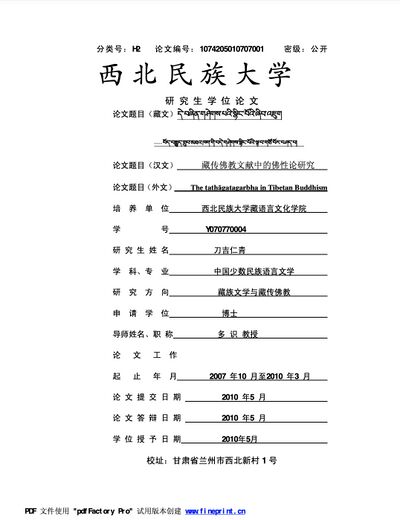This is a PhD dissertation on Buddha-Nature in Tibetan traditions written in Tibetan by Rinchen Dorje in 2010 in Lanzhou, Gansu Province.
Abstract
The Tathāgatagarbha in Tibetan Buddhism.
The Tathāgatagarbha concept is a fundamental philosophical question of Buddhism. Tathāgatagarbha (Sanskrit) has the original contextual meaning of "embryonic Buddha" (Tib: bade gashegas snginga po) or "Buddha heart". Mahāyāna Buddhism, Vajrayana Buddhism, and particularly the Prāsangika school expresses the term as "Buddha nature". Within the three surviving nikayas[1] of Theravada Buddhism, there are several ways of understanding tathāgatagarbha and according to different sutras. The most significant doctrines lie in the Tathāgatagarbha, Lankavatara, Mahaparinnirvana, Maharatnakuta, Mahabheri Haraka Parivarta, and Angulinalya sutras, which define tathāgatagarbha as a monism and something permanent. Prāsangika and Tibetan Buddhism schools (Nyingma, New Bön, Kadam, Sakya, Jonang, Gelug, Kagyu) meanwhile, see tathāgatagarbha as an expression of the concepts of pratīyasamutpāda (dependent arising) and sūnyatā (emptiness). Many researchers believe that the Tibetan Buddhist practice of mahasampanna (Eng: Dzogchen, Tib: rdzogas chena) and Mahamudra (Eng: the Great Seal, Tib: phyga rhy chen mo) are based on the concept of an "absolute" tathāgatagarbha.
In this paper I focus on the Tibetan Buddhist interpretation of tathāgatagarbha and argue that its concept concerns "emptiness" and "dependent arising" but nothing else. I have five main arguments: 1) All Tibetan Buddhist schools, in theory and practice, assert that they follow Mahāyāna Buddhism and its Prāsangika school; Tibetan Buddhism is enshrined in the doctrines of both Nāgārjuna and Candrakīrti who both stated that ultimate truth is sūnyatā but not atman (infinite, ego-less, svabhava); 3) Nagarjuna’s Mūlamadhyamakakārika declares: "whatever is relational origination [pratītyasamutpāda] is sūnyatā" which means that all phenomena (dharmas) are sūnyatā including Buddha nature; 4) The Tibetan Buddhist schools insist that all Buddhist sutras be explained in terms of Nāgārjuna’s theory and wisdom. The Buddha himself prognosticated Nāgārjuna as his re-disseminator and this is recorded in several scriptures, for instance Tsongkhapa's In Praise of Dependent Arising; and 5) Tibetan Buddhist schools agree on the tathāgatagarbha concept and this understanding corresponds with the principles of Buddhist scripture, in particular the "revelation of the whole truth" and "partial revelation of the truth", the four seals of Buddha truth (chatur udan) and the four reliances (catrari pratisaranan).
Tibetan Buddhist schools stress that in the three turnings of the wheel of the Buddha's doctrine (tridharmachakra), the second teaching of the "perfection of wisdom" (prajna) or "wisdom of emptiness" is central, the Heart Sutra (Prajnapramit-hridaya Sutra ) containing the wisdom of salvation. Tathāgatagarbha is the main teaching of third of the tridharmachakra and should be combined with the wisdom of emptiness. Hopkins [1973:p323] states: "The prasangikas say that this teaching [of the concept of tathāgatagarbha] is an example of giving to the cause the name of effect; for, the emptiness of the mind of each sentient being is what allows for change of that sentient being’s mind, and this emptiness if being called a fully enlightened Buddha".
In conclusion, I am arguing that the concept of tathāgatagarbha in the Tibetan Buddhist schools – being simply emptiness and dependent arising – includes the view of the Tibetan Buddhist Dzogchen school and its gazhanastaonga (Eng: wrong view concerning unrealness of the attributes) text and tradition. In this vein, Tibetan Buddhist sects also contend that several Mahayana Buddhist scriptures such as the Mahaparinirvana, Tathāgatagarbha, Srimladevimhanada and Mahayana Angulimaliya sutras, which describe tathāgatagarbha as omniscient, eternal, infinite, pure, benevolent, nurturing, ultimate nature, unconditioned, changeless, virtuous or ineffable are to be understood as only "partial revelation of the truth" and not "revelation of the whole truth". After all, tathāgatagarbha in Tibetan Buddhism is emptiness or wisdom of emptiness but nothing else. In fact, according to Tibetan Buddhism, the two-in-one (yuganaddha, Tib: zunga vajuga;) of emptiness and bodhicitta, means that we can attain the final Buddhist goal of enlightenment. This is why tathāgatagarbha is the cornerstone of all Buddhist teaching.
Notes
- The three nikayas or monastic fraternities are Theravada, in Southeast Asia; Dharmaguptaka in China, Korea and Vietnam; and Mulasarvastivada in the Tibetan
tradition.
| Citation | Dorje, Rinchen. De bzhin gshegs pa'i snying po'i zhib 'jug (The Tathāgatagarbha in Tibetan Buddhism). PhD diss., Lanzhou, Gansu Province, 2010. |
|---|---|

